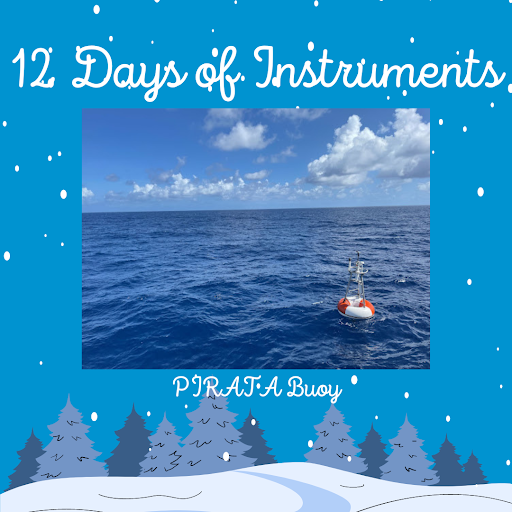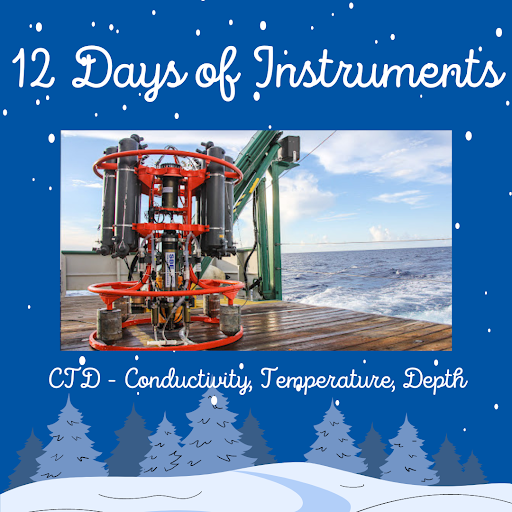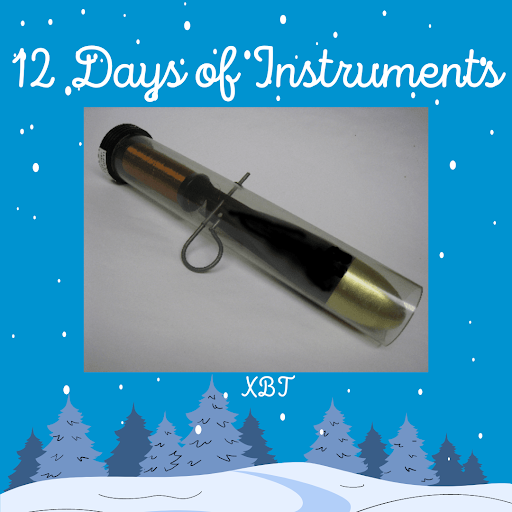Introducing a new social media series from NOAA’s Atlantic Oceanographic and Meteorological Laboratory (AOML): 12 Days of Instruments!
This series highlights 12 of the many instruments used by our researchers at AOML! Each of these instruments are vital to conducting our groundbreaking research.
On the First Day of Instruments, AOML Sent to Me…
One SASe!
SASe, which stands for Subsurface Automated Sampler for Environmental DNA (eDNA), is an important device for understanding the biodiversity of certain ecosystems. The SASe collects water samples which pick up on eDNA, DNA that has been shed by an animal into its environment. Understanding what species are present in marine ecosystems can be very important for the management of endangered species, invasive species, and overall ecosystem health!
To learn more about eDNA, watch our eDNA video series!

On the Second Day of Instruments, AOML Sent to Me…

A PIRATA buoy with TACO sensors!
The Prediction and Research Moored Array in the Tropical Atlantic (PIRATA) is an multinational network of ocean buoys that serves as the backbone of the tropical Atlantic observing system.
PIRATA buoys measure subsurface ocean temperature, salinity, velocity and sea surface variables like wind direction and speed, air temperature, humidity, solar radiation, and rainfall.
Additionally, Aquadopp current meters (sensors) can be attached to the PIRATA buoys in the upper 100 meters, as part of the AOML-funded Tropical Atlantic Current Observations Study (TACOS). TACOS seeks to resolve how strong wind events, including tropical storms and hurricanes, affect ocean currents, mixing, and air-sea interactions in this region. These sensors add to the measurements already being collected at PIRATA moorings by extending the vertical profile of observations collected.
Buoys in the PIRATA array provide critical real-time data for models of the Atlantic climate system, which are used globally for ocean and weather prediction.
On the Third Day of Instruments, AOML Sent to Me…
A GPS Dropsonde!
Scientists release sensors tethered to parachutes, known as GPS dropsondes, which gather profiles of atmospheric data, recording wind speed and direction, temperature, relative humidity and pressure. Dropsondes are deployed from NOAA’s Hurricane Hunter aircraft over data-sparse oceanic areas at specific altitudes and measure storm conditions as they fall to the ocean’s surface.
Dropsonde measurements provide a detailed look at a tropical storm’s structure and intensity, enabling forecasters to map the steering currents that influence its movement. Wind observations from dropsondes also help properly characterize a storm’s wind field structure.

On the Fourth Day of Instruments, AOML Sent to Me…

An Underwater Glider!
An underwater glider is an autonomous underwater vehicle (AUV) that uses small changes in buoyancy together with wings to propel itself by converting vertical motion into horizontal motion as it travels through the ocean. The gliders are battery-powered and deployed during hurricane season for up to four months and then recovered.
AOML underwater gliders have sensors to monitor the following parameters: temperature, salinity, dissolved oxygen, chlorophyll concentration, and CDOM – Chromophoric Dissolved Organic Matter. Gliders are commanded remotely via satellite and data transmissions are performed in real-time for immediate use in scientific analysis and hurricane forecast models. AOML’s Hurricane Glider project is a multi-institutional effort to implement and carry out sustained and targeted ocean observations from underwater gliders in the Caribbean Sea and tropical North Atlantic Ocean in support of hurricane studies and forecasts.
On the Fifth Day of Instruments, AOML Sent to Me…
A Water Quality Sensor!
This specific water quality sensor has been implemented at Port Everglades, in Fort Lauderdale, Florida! Located near the navigation channel, this water quality sensor uses acoustic modems to transmit data collected at the seafloor to a surface buoy. Data is then sent to a computer server via cell communications in near real-time!
The water quality instrument at the seafloor is surrounded by corals and sponges that form vital benthic habitats for many fish and invertebrate species. Placing this sensor here allows for the collection of turbidity (the cloudiness or haziness of a fluid due to particles), temperature, salinity, the amount of solar radiation that reaches the seafloor, current velocity/direction, wave action, and changes in sediment accumulation on the seabed data.
You may be wondering….why are we collecting all those different things?
By collecting these different kinds of data, AOML scientists are able to determine whether corals near the port’s navigation channel are being negatively impacted by ongoing dredging activity at the port.

On the Sixth Day of Instruments, AOML Sent to Me…

A Saildrone!
Saildrones are uncrewed surface vehicles powered by wind and solar energy and are remotely piloted. They are capable of making multiple concurrent measurements of the environment including wind speed, wave height, temperature, pressure, and salinity. Saildrones are equipped with a special “hurricane wing” (which looks like a hard sail) to withstand the extreme wind conditions encountered in storms as they gather data from the near-surface ocean and atmosphere in real-time.
The data are used to improve our understanding and prediction of tropical cyclone intensity changes and advance our knowledge of the ocean-atmosphere interactions that fuel them.
On the Seventh Day of Instruments, AOML Sent to Me…
A Small Uncrewed Aircraft System (sUAS)!
Small Uncrewed Aircraft Systems (sUAS) are deployed from NOAA’s P-3 Hurricane Hunter aircraft into tropical cyclone environments. The autonomous nature of these small drones, such as the Area-I Altius 600, provides a unique observation platform that is capable of accurately measuring atmospheric pressure, temperature, humidity, winds & sea surface temperature at altitudes manned aircraft are unable to fly.
Using sUAS technology allows scientists to collect measurements at low altitudes within storms and can provide insight into processes that influence hurricane intensity. Advances in technology like these are improving hurricane forecasts.

On the Eighth Day of Instruments, AOML Sent to Me…

A Biogeochemical Argo Float!
Biogeochemical (BGC) Argo Floats are an incredible instrument used to collect a wide array of data from the water column. These free floating floats can move between the surface and 2,000 meters in depth, taking measurements using 6 or more delicate sensors. These floats have sensors which measure oxygen, nitrate, pH, chlorophyll-a, irradiance, particles, temperature, and salinity simultaneously.
Forecasts generated by these real-time floats have the potential to serve marine resource managers of fisheries, protected species, and coral reef ecosystems, as well as researchers, by providing environmental data to understand links with dynamics like distribution, recruitment, catch, and disease!
On the Ninth Day of Instruments, AOML Sent to Me…
A CTD/O2/LADCP!
CTD stands for conductivity, temperature, and depth, and refers to a package of electronic instruments that measure these properties. A CTD device’s primary function is to detect how the conductivity and temperature of the water column changes relative to depth. These devices also have the ability to take water samples at varying depths which is important for studying the physical and chemical properties of seawater. Biological processes are also uncovered with this data and can give scientists a look into the distribution of species and changing environmental conditions.
Oxygen (O2) sensors on this device have the ability to observe oxygen levels at varying depths. This is important for learning about ocean chemistry and phenomena such as dead zones and hypoxia.
Lowered acoustic Doppler current profilers (LADCP) measure water currents with sound, using a principle of sound waves called the Doppler effect. Scientists use the instrument to measure how fast water is moving across an entire water column.

On the Tenth Day of Instruments, AOML Sent to Me…

A Drifter!
Drifters drift with the ocean currents and send their location back to scientists via satellites. Drifters used for the Global Drifter Program at AOML measure sea surface temperature using a thermistor at the base of the float, but most are also equipped to measure other variables. As the drifter moves around, guided by ocean currents, measurements of atmospheric pressure, winds, wave height, and salinity can be taken. This data is collected by sensors in the drifter and transmitted to overhead satellites. Tracking the location of drifters over time allows scientists to build a profile of ocean currents.
A drifter’s drogue, also known as a sea anchor, extends 20 meters (or 65 feet) deep and is designed to move with the near-surface ocean currents. The drogue and surface float move together, connected by a long tether. Without a drogue, the drifter will be transported by wind and waves, much as a beach ball is pushed across the surface of a pool.
On the Eleventh Day of Instruments, AOML Sent to Me…
A Tail Doppler Radar!
The Tail Doppler Radar (TDR) system is located at the back end of all three NOAA Hurricane Hunter aircraft. As the plane flies through a storm, the TDR continuously measures cross-sections of precipitation and winds.
By piecing together these cross-sections, scientists can create a three-dimensional image of the storm. This three-dimensional “CAT scan” can show where the strongest winds are, how far the strong winds extend out from the storm center and where the most intense rainfall occurs.

On the Twelfth Day of Instruments, AOML Sent to Me…

An eXpendable BathyThermograph (XBT)!
An eXpendable BathyThermograph (XBT) is a probe that is deployed from a ship along fixed routes that are referred to as “transects”, and measures the temperature as it falls through the water. A very thin wire transmits the temperature data to the ship where it is recorded for later analysis. XBTs do not measure depth directly (e.g. using a pressure sensor). Instead, fall-rate equations are used to derive the depth of the XBT as a function of time after the XBT is deployed into the ocean.
After deployment, data collected from XBTs are transmitted in real-time to data distribution centers (e.g. The Global Telecommunication System). These XBT measurements are used to monitor changes of key surface and subsurface currents, to study meridional heat transport in all ocean basins, and assess the variability of the upper ocean heat content.
Airborne eXpendable BathyThermographs (AXBTs) can also be deployed from NOAA’s P-3 Hurricane Hunter aircraft.
Don’t forget to follow us on social media to see our posts live!
You can find us on:
Instagram: @noaa_aoml
Twitter: @NOAA_AOML
Facebook: @noaaaoml
